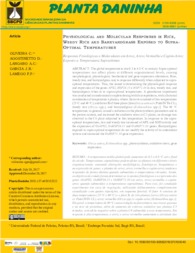Physiological and molecular responses in rice, weedy rice and barnyardgrass exposed to supraoptimal temperatures.
Physiological and molecular responses in rice, weedy rice and barnyardgrass exposed to supraoptimal temperatures.
Summary: A temperatura média global pode aumentar de 0,3 a 4,8 oC até o final do século. Temperaturas supraótimas podem afetar as plantas em diferentes níveis organizacionais, causando alterações morfológicas, fisiológicas, bioquímicas e na expressão de genes, e plantas de arroz, arroz-vermelho e capim-arroz tendem a responder de forma distinta quando submetidas a temperaturas elevadas. Assim, os objetivos do estudo foram determinar as respostas fisiológicas e a expressão dos genes OsAPX2, OsHSP24.15 e OsHSP71.10 em arroz, arroz-vermelho e capim-arroz quando submetidos a temperaturas supraótimas. Para isso, foi conduzido experimento em casa de vegetação, utilizando delineamento completamente casualizado com quatro repetições, em esquema fatorial. O fator A constou de duas temperaturas (25 oC e 40 oC) e o fator B, de três plantas [arroz (Oryza sativa cv. Puitá INTA-CL), arroz-vermelho (Oryza spp.) e capim-arroz (Echinochloa spp.)]. Em geral, a temperatura de 40 oC causa redução na fotossíntese, nas trocas gasosas e no teor de proteínas, além de aumento do estresse oxidativo nas plantas C3 testadas, sem efeito negativo sobre a planta C4 submetida a essa temperatura. Em resposta à alta temperatura, o arroz e arroz-vermelho aumentam a atividade das enzimas APX e SOD e a expressão dos genes OsAPX2, OsHSP24.15 e OsHSP71.10; no capim-arroz, apenas ocorreu aumento na expressão do gene HSP71.10. The global temperature to rise 0.3 to 4.8 oC to century. Supra-optimal temperatures can affect plants at different organizational levels, causing morphological, physiological, biochemical and gene expression alterations. Rice, weedy rice, and barnyardgrass may to response differently when subjected to supra-optimal temperatures. Thus, the aimed at determining the physiological response and expression of the genes APX2, HSP24.15 e HSP71.10 in rice, weedy rice, and barnyardgrass when in to supra-optimal temperatures. A greenhouse experiment was conducted in randomized complete desing with four repetitions, with a factorial combination of temperature x plantas, where: factor A consisted of two temperatures (25 oC and 40 oC); and factor B of three plants [rice (Oryza sativa cv. Puitá INTA-CL), weedy rice (Oryza spp.), and barnyardgrass (Echinochloa spp.)]. The 40 oC temperature, in general, caused a reduction in the photosynthesis parameters and in the protein content, and increased the oxidative stress in C3 plants; no damage was observed in the C4 plant subjected to this temperature. In response to the supra-optimal temperatures, rice and weedy rice increased of APX and SOD activity and the expression of OsAPX2, OsHSP24.15 and OsHSP71.10 genes. Barnyardgrass exposed to supra-optimal temperature do not modify the activity of its antioxidant system and increased the OsHSP71.10 gene expression.
Publication year: 2019
Types of publication: Journal article
Keywords: Arroz, Fotossíntese, Oryza Sativa, Resistência a Temperatura, Stress
Observation
Some of Embrapa's publications are published as ePub files. To read them, use or download one of the following free software options to your computer or mobile device. Android: Google Play Books; IOS: iBooks; Windows and Linux: Calibre.
Access other publications
Access the Agricultural Research Database (BDPA) to consult Embrapa's full library collection and records.
Visit Embrapa Bookstore to purchase books and other publications sold by Embrapa.

